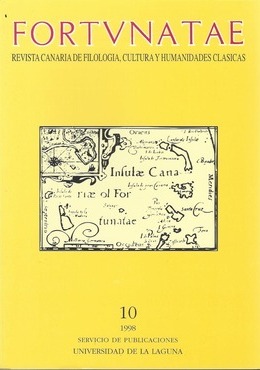Los procedimientos lexicales para la expresión del género en latín
Resumen
The aim of this paper is to summarize the views of differents scholars on heteronymy and on the lexemes of complementation or supporting lexemes, that is, the lexical devices used for expressing gender in Latin. Heteronymy is studied here through distinguishing the two lexical series in which it appears: kinship names and domestic animal names. In reviewing them one reaches the conclusion that Latin has inherited not only the majority of Indoeuropean heteronymic couples, but has also created new ones in the course of its evolution. With respect to the complementation terms, mas/femina, the study offers the lexical groups in which such supporting lexemes are used, viz. a) for distinguishing sex in names of common gender (communia nomina) or epicene (epicoena nomina) and in names of animals used as victims of ritual sacrifices; b) for other technical classifications; and c) for indicating the terminology of grammatical gender in early grammarians.
Citas
ADAMS, J. N., 1977: «The Vocabulary of the Annales Regni Francorum», Glotta 55, 257-282.
ALVAR, M.; y B. POTTIER, 1983: Morfología histórica del español. Madrid, Gredos.
BASSOLS, M., 1945: Sintaxis histórica de la lengua latina. Barcelona, CSIC («El género gramatical», pp. 43-71).
BONNET, M., 1890 (= Hildesheim, Olms, 1968): Le latin de Grégoire de Tours. París.
CARNOY, A. J., 1906 (= Hildesheim-Nueva York, Olms, 1971): Le latin d’Espagne d’après les inscriptions. Etude linguistique. Bruselas.
CGL: Corpus Glossariorum Latinorum, edd. G. LOEWE y G. GOETZ. Amsterdam, Hakkert, 1965 (I-V vols.)
CIL: Corpus Inscriptionum Latinarum. Berlín, desde 1863 (I-XVIII vols.)
COLLART, J., 1954: Varron, grammairien latin. París.
DAHLMANN, H., 1966-2 : Varro. De lingua latina, Buch VIII. Berlín, Weidmann.
DCEC: Diccionario crítico etimológico de la lengua castellana, J. COROMINAS. Madrid-Berna, Gredos, 1954-1957.
DÍAZ Y DÍAZ, M. C., 1966: «Los documentos hispano-visigóticos sobre pizarra», Studi Medievali 7, 80.
DÍAZ Y DÍAZ, M. C., 1986: «Algunos aspectos lingüísticos y culturales de las pizarras visigóticas», Myrtia 1, pp. 13-25.
DU CANGE: Glossarium Mediae et Infimae Latinitatis, ed. L.FAVRE. Graz, 1883-1887 (= 1954, I-X vols.)
ERNOUT, A., 1908: «Remarques sur l’expression du genre féminin en latin», Mélanges F. de Saussure, pp. 211-222
ERNOUT, A.; y A. MEILLET, 1967-4 : Dictionnaire étymologique de la langue latine. Histoire de mots. París, Klincksieck.
FERNÁNDEZ-RAMÍREZ, S., 1986: Gramática española. 3.1. El nombre. Ed. J. Polo. Madrid, Arco.
FEW: Französisches etymologisches Wörterbuch, W. VON WARTBURG. BonnBasilea, 1922-1986.
GONZÁLEZ LUIS, F., 1992: «Los diminutivos latinos y su género gramatical», Fortunatae 3, pp. 251-264.
GRF: Grammaticae Romanae fragmenta, ed. H. FUNAIOLI. Stuttgart, Teubner, 1907 (= reimpr. 1969).
HJELMSLEV, L., 1972: «Para una semántica estructural», en Ensayos lingüísticos, trad. E. Bombín y F. Piñero. Madrid, Gredos.
HOFMANN, J. B.; Y A. SZANTYR, 1965: Lateinische Syntax und Stilistik. Munich (Handbuch der Altertumswissenschaft).
LASSO DE LA VEGA, J. S., 1968: Sintaxis griega. Madrid, C. S. I. C.
LEUMANN, M., 1963: Lateinische Laut- und Formenlehre. Munich.
LÖFSTEDT, B., 1963: «Bemerkungen zum Problem Genus : Sexus im Lateinischen», Symbolae Osloenses 38, 47-68.
LÖFSTEDT, E., 1956: Syntactica. Studien und Beiträge zur historischen Syntax des Lateins, t. II, Lund, C. W. K. Gleerup.
LÓPEZ-SANTAMARÍA, F. J., 1991: «Los nombres de parentesco en latín», en Actes del Xiè Simposi de la secció catalana de la SEEC, I, Barcelona.
MAGARIÑOS, A.., 1933: «Sus, porcus, porca, aper», Emerita 1, pp. 129-134.
MARINER, S., 1953: «Sobre los orígenes de la caracterización morfológica del femenino y lenguas afines», Helmantica 4, pp. 341-371.
MARINER, S., 1977: «Parentes-cognati et affines. Una motivación del cambio a partir de Hier.: Adu. Rufinum II 2», Helmantica 28, 341-352.
MEILLET, A., 1931: «Essai de chronologie des langues indoeuropéennes. La théorie du féminin», BSLP 32, 1-28.
MEILLET, A.; y J. VENDRYES, 1966-4 : Traité de grammaire comparée des langues classiques. París, Champion.
MEYER-LÜBKE, W., 1890-1906 (= reimpr. Marsella, 1974): Grammaire des langues romanes. II. Morphologie. París.
MLLM: Mediae latinitatis lexicon minus, J. F. NIERMEYER. Leiden, Brill, 1954-1976.
MONTEIL, P., 1973: Eléments de phonétique et de morphologie du latin. [París], éd. F. Nathan.
NEUE F.; Y C. WAGENER, 1902 (= Hildesheim, Olms, 1985): Formenlehre der Lateinischen Sprache. I. Das Substantivum. Leipzig.
PIRSON, J., 1901 (= 1967): La langue des inscriptions latines de la Gaule. Bruselas.
PISSANI, V., 1974 4 : Grammatica latina, storica e comparativa. Turín.
PLANTA. R. VON, 1892-1897: Grammatik der oskisch-umbrisches Dialekte, II. Estrasburgo.
REW: Romanisches etymologisches Wörterbuch, W. MEYER-LÜBKE. Heidelberg, 1935-3.
ROHLFS, G., 1979: Estudios sobre el léxico románico, trad. M. Alvar. Madrid, Gredos.
SOFER, J., 1930 (= Hildesheim-Nueva York, Olms, 1975): Lateinisches und Romanisches aus des Etymologiae des Isidorus von Sevilla. Untersuchungen zur lateinischen und romanischen Wortkunde. Gotinga.
ThLL: Thesaurus Linguae Latinae. Leipzig-Munich, desde 1900.
WACKERNAGEL, J., 1926 (= 1957-2 ): Vorlesungen über Syntax II. Basilea.
WARTBURG, W. VON, 1951: Problemas y métodos de la lingüística, trad. de A. Alonso y E. Lorenzo. Madrid, CSIC.
WÖLFFLIN, E., 1878: «Bemerkungen über Vulgärlatein», Philologus 34, pp. 137-165.
Los autores conservan los derechos de autor y garantizan a la revista el derecho de ser la primera publicación del trabajo al igual que licenciarlo bajo una Creative Commons Attribution License que permite a otros compartir el trabajo con un reconocimiento de la autoría del trabajo y la publicación inicial en esta revista.
Los autores pueden establecer por separado acuerdos adicionales para la distribución no exclusiva de la versión de la obra publicada en la revista (por ejemplo, situarlo en un repositorio institucional o publicarlo en un libro), con un reconocimiento de su publicación inicial en esta revista.





